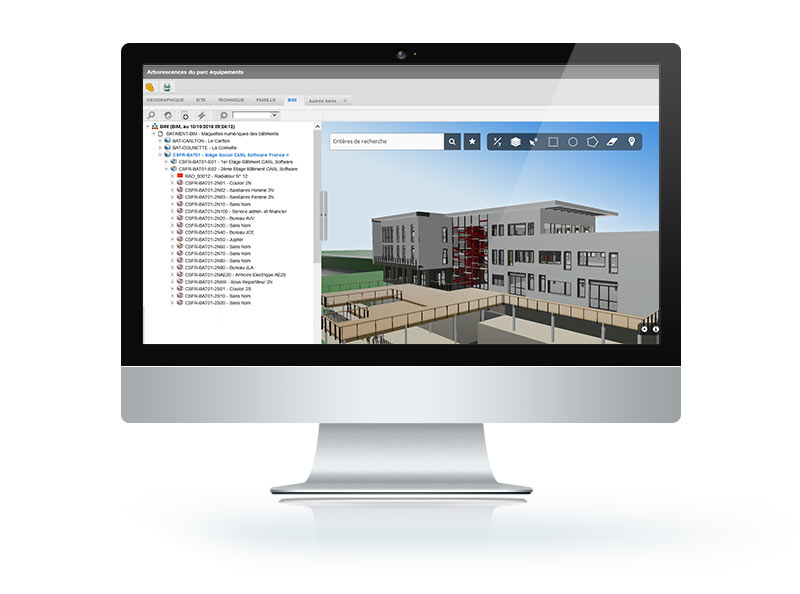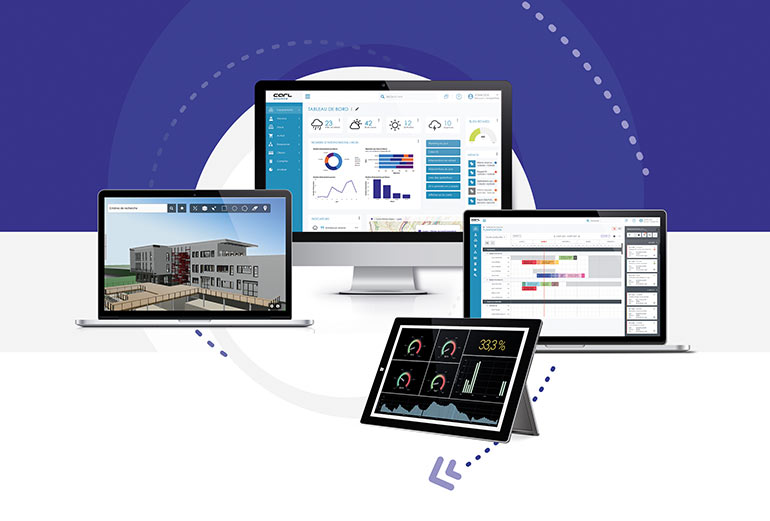CMMS in the facilities sector
Building Management System (BMS) & Technical Asset Management (TAM)
La GMAO, le pivot digital du Facility Management
Property Management, Facility Management (FM), Asset Management (EAM): this refers to the life of buildings, installations, networks, technical equipment, etc. placed at the service of people (users, customers, occupants) who use them, and under the administrative, security or regulatory responsibility of property owners and managers (Property Manager, Asset Manager, Facility Manager).
Property is no longer a “simple” technical object. It is at the heart of a process of exchanges and interactions between numerous human (technical services, subcontractors, occupants…) and technical (BMS, supervision…) players. In this new digital reality, the CMMS is an essential digital pillar, bringing together the technical and economic life of an asset throughout its lifecycle, from construction to demolition. Today, without it, it’s impossible to have the knowledge needed to anticipate, simulate or optimize its lifespan and energy performance.
In concrete terms, “On one hand, there are the occupants of a building. On the other hand, there are those who operate and maintain it, and who listen to the occupants. For some years now, we’ve been “servicing” our property assets, with the objectives of making them more comfortable for occupants to work in. CMMS (Maintenance and Operations Management), as an asset management tool, is an indispensable asset in this transformation,” sums up Laurent Truscello, product marketing manager for facility management at CARL Berger-Levrault. Indeed, everything starts with the property user, and his or her quality of life in the environment. For him, access to the CMMS is simplified, direct, practical and mobile.
Customer success stories: Read Alstef’s testimonial “Maintaining airport baggage sorting systems”
CMMS at the heart of building operation management and occupant satisfaction
Whether a tenant, employee or customer reports a breakdown or malfunction, the CMMS immediately comes steps in. It can be used to designate, alert, brief and guide the right technical personnel (subcontractors or maintenance technicians), and if necessary, follow-up, monitor their work or report any failure in their mission. The CMMS solution ensures dialogue between the client and the technical operator, assessing the satisfaction of the client and the efficiency of the technical operator thanks to the traceability of actions carried out. It generates indicators such as efficiency rates, the breakdown between corrective and preventive action, etc., which managers will strive to improve, or will study to check compliance with contractual commitments negotiated with their subcontractors. In short, CMMS is the manager’s key tool for ensuring the proper operation of the building for which he or she is responsible, controlling all processes and guaranteeing the best possible service to occupants.
Finally, the range of services offered has expanded. In addition to troubleshooting requests, we now also handle moving requests, work requests, energy performance-related work, etc. At times, a dedicated CMMS-based portal can be used to share all the site useful information such as: opening hours, canteen menu, concierge service, etc. With the CMMS, the manager covers all needs related to the operation and occupation of a building.
Manage with a CMMS to increase equipment durability and performance
Asset Managers and Property Managers have access to a centralized inventory of their assets and a health record of their assets at all levels (sites, buildings, premises, land, technical equipment, etc.). Having their own system gives them independence from service providers, and continuity in performance analysis in the event of changes over time.
Because nothing lasts forever, assets and equipment deteriorate over time. Knowledge of the assets identified in the CMMS is a prerequisite for programming major works or renovations. By adding data on preventive plans (changing filters every 2 years, checking fire extinguishers every year, etc.) and the state of health of equipment in real time, the solution brings together the data needed to make the right decisions.
Property Managers and Asset Managers can therefore make the right decisions about the future of their assets, and invest with full knowledge of the facts. An over-consuming air-conditioning system or a faulty type of equipment can be replaced rather than maintained. On the other hand, high-performance equipment can be extended, and maintenance activities adapted to real conditions. The financial and budgetary aspect is at the heart of , and is undoubtedly a key factor in the policies implemented. Once strategies have been confirmed, they will be implemented by maintenance teams or service providers. All these projects are planned and monitored in the CMMS. As a result, technical and economic traceability is complete in the asset repository.the CMMS tool, and is undoubtedly a key factor in the policies implemented. Once strategies have been confirmed, they will be implemented by maintenance teams or service providers. All these projects are planned and monitored in the CMMS. As a result, technical and economic traceability is complete in the asset repository
 Press Reviews: Implementing a CMMS for better technical management of buildings.
Press Reviews: Implementing a CMMS for better technical management of buildings.
CMMS makes it easier to understand your assets
Viewing assets, networks and infrastructures on a map, like Google Maps, simplifies understanding and provides a geographical context for maintenance activities. Plans, on the other hand, provide the indoor dimension of buildings. Modern asset CMMS therefore incorporate this multi-scale cartographic dimension, to help maintainers understand the systems they need to manage, and to inform Property Managers’ decisions so that they have a better understanding of the assets they are responsible for. The contribution of maps is also useful for processes linked to space management, such as monitoring moves, managing surface areas and usage, managing occupants, etc., which enrich the range of software solutions.
The arrival of BIM (Building Information Model) brings to the CMMS the data needed to initialize equipment tree structures, from which maintenance processes will be based, but also an understanding of networks (electrical, VMC, etc.) thanks to their 3D reconstruction. For infrastructures, or linear networks, we speak of CIM, for City Information Model. By anchoring BIM models in a given territory, it is easier to understand a complex system in its environment.
BIM and CIM are becoming a standard feature of CMMS and facility management solutions. In this way, the promise of moving from As Built to As Maintained becomes a reality. Construction BIM thus finds digital continuity with operation and maintenance BIM. For existing assets, Lidar scans or other modelling techniques can be used to reconstitute data to create a graphic digital twin of the asset.
CMMS, an interconnected, open, multi-source platform
When it comes to asset management, CMMS is necessarily connected to a host of sources and systems. These systems may be internal, such as Building Management Systems (BMS), supervisory systems or hypervisors (e.g. BOS = Building Operating System). In real time, alarms and counters condition maintenance activities or provide information on the state of health of installations, enabling action to be taken at the right moment. CMMS can also be combined with portals to share a broader experience of building services (e.g. concierge services, catering, management of site entry badges, etc.).
The systems can also be external to the company’s IS. To avoid unnecessary data entry and, above all, to guarantee the reliability of regulatory diagnostic data, all inspection reports can be synchronized with inspection platforms. Maintenance work required to correct non-conformities is generated automatically. Today, knowledge of the regulatory status of an establishment or infrastructure is essential in terms of personal safety. Indeed, owners are increasingly exposed to legal action in the event of non-compliance. This traceability is therefore the responsibility of all those involved in the contractual maintenance of assets.
CMMS is also open to FMeurs tools, to facilitate the collection of Maintenance work reports when they are produced using the subcontractor’s tools. The important thing is to centralize information in the CMMS, whatever the source.
CMMS becomes the data platform that unifies asset information throughout the asset lifecycle (from construction to retirement). It is also open to securely share asset lifecycle data with a range of systems. In this way, it is possible to share the availability of a meeting room, taking into account unavailability for maintenance, to display current requests or maintenance work carried out, to share activities on dashboards via BI (Business Intelligence) software…
“CARL Touch is the essential tool that our field technicians use to guarantee fast, efficient Maintenance work and to maintain our equipment in optimum condition”.
Benoît Lepointe – Head of Maintenance Engineering, Alstef Group
CMMS, Asset Management and Space Management
An excellent CMMS offers you more than just maintenance, it can also meet your asset management needs (EAM). It offers inventory functions that let you know what happened to the printer from the F115 office: Using fixed labels with barcodes and QR codes can be used to scan equipment, which can now be traced. Visualization devices make it easier for staff to move in or out: you can see whether a particular desk is occupied, whether it is configured to accommodate a third desk, or what equipment is missing. Several Space Management functions are available.
The CMMS solution can also be used to manage asset processes such as leases, plots, surface areas… and even track rental payments to find out if a tenant is in default. It also offers the possibility of administering other equipment within the same property: a fleet of vehicles, green spaces, the manager’s IT equipment etc.
CMMS, energy performance of assets and equipment
Rising energy prices and their impact on property management have logically led asset managers to ask the CMMS to monitor consumption and optimize heating, air conditioning and lighting systems. Connecting water or electricity meters can generate alerts if consumption rises unusually high. A comprehensive approach to the system can mean taking the opportunity of a leak to adjust or modernize the heating system. CMMS can collect data directly from energy performance tools (such as BL.Predict), or offer direct connectors with energy suppliers (e.g. ENEDIS or GRDF in France). The platform approach provides a macroscopic view of energy-intensive buildings or infrastructures, and comparisons in m2 for buildings according to their use. What’s more, thanks to technical knowledge of equipment, and modern monitoring tools based on connected objects, it’s easy to under-count. All data collected can be used to improve the equipment energy performance. In some countries, performance measurements are mandatory. In France, for example, the BACS and TERTIAIRE decrees require managers to demonstrate their progress.
We need to be able to propose action plans to further reduce energy consumption, while ensuring that equipment consumption does not deteriorate over time. CMMS is therefore a key element in supporting the ecological transition, particularly for existing installations.
In short, as part of our Corporate Social Responsibility (CSR) approach, maintenance is entrusted with the task of ensuring that equipment operates “as efficiently as possible”, in terms of both efficiency and energy consumption.
The key benefits of a CMMS for Facility and Building Management:
- Improve user and occupant satisfaction.
- Centralize knowledge ofassets.
- Reduce maintenance and contract costs.
- Increase equipment life and availability.
- Optimize the energy performance of installations.
- Ensure the safety and well-being of occupants.
Our latest references in the Facility Building sector
Our CMMS solution for Facility Management: CARL Source Facility
CARL Source Facility is our software solution for the technical management of real estate assets, infrastructures and networks in the service sector. This facility management solution has been designed in partnership with major players in the field, to help you optimize the maintenance and operation of your real estate assets. Our Facility range enables you to control your real estate assets, guaranteeing equipment availability and personnel safety, monitor your service providers and manage your maintenance contracts and activities in real time, while reconciling quality and budgetary control.



